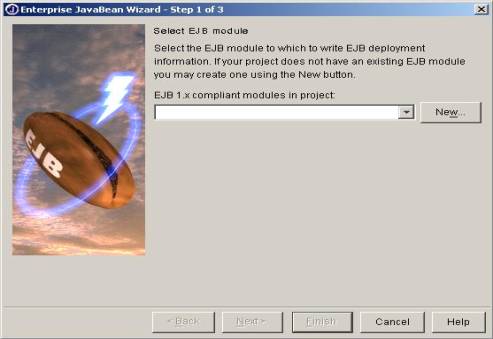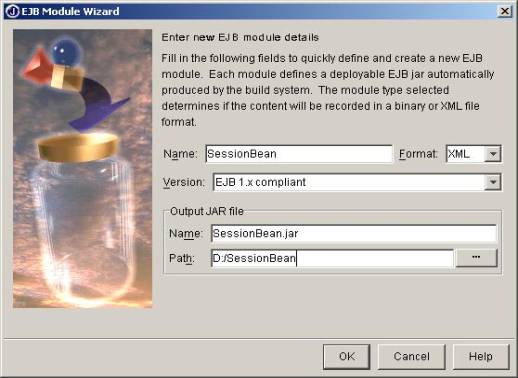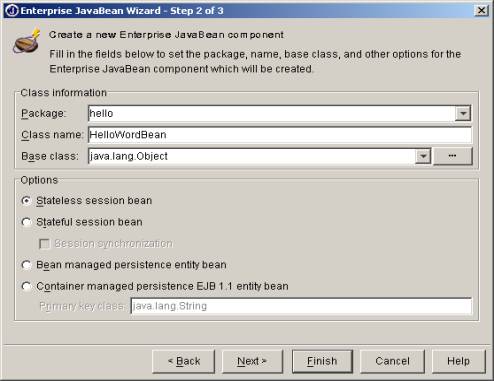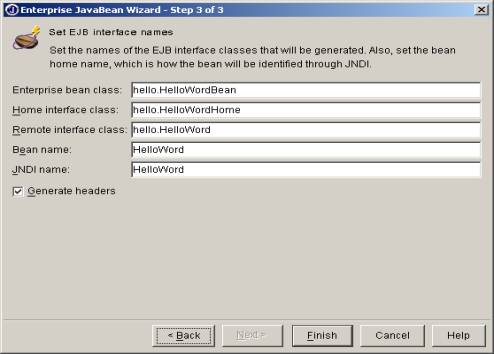一、環境的建立
1、Weblogic6.0與ejb相關的環境配置
與數據庫發生關系的EJB,所以需要建立一個ConnectionPool和DataSource。
●創建ConnectionPool
(1)我使用的是ORACLE8I數據庫。將classes12.zip(oracle的type4類型jdbc驅動程序)拷貝到bea的相關目錄(我這兒放在了mydomain下的lib目錄下)。然後在setenv.cmd中的"set CLASSPATH="後面加上%WL_HOME%\config\mydomain\lib\classes12.zip;將驅動程序加入到classpath中。
(2)啟動weblogic並打開控制台(http://127.0.0.1:7001/console),選擇左面數型結構的功能欄中的Services-----JDBC----Connection Pools---Create a new JDBC Connection Pool。
(3)Name欄中輸入自己為該Pool定義的名稱。例如:TestConnectionPool
在URL中輸入:jdbc:oracle:thin:@127.0.0.1:1521:oracle (IP、端口號、服務名按照自己的修改);
在Driver Classname欄中輸入:oracle.jdbc.driver.OracleDriver;
在Properties(key=value)欄中輸入:
user=scott
password=tiger
dll=ocijdbc8
protocol=thin
分別是數據庫連接用戶名、密碼、動態連接庫以及協議(其中用戶名和密碼按自己的修改)。
在Target頁簽中選擇服務器名,並Apply。
(4)、其他的參數設置例如Intial Capacity等可以自己按照字面意思進行配置。
●創建Data Source
(1)、在左面樹型結構的Services---JDBC---Data Sources下Create a new JDBC Data Source
(2)、在Name中輸入自己定義的名稱
例如:TestDataSourc,在JNDI Name欄中輸入:自己定義的名稱;
例如:CRMDBSource,在Pool Name中輸入剛才創建的JDBC Connection Pool的Name, 上面的TestConnectionPool,在Targets頁中選擇服務器名稱並Apply即可。
這樣就在Weblogic6.0中建立了ORACLE的數據庫連接池和數據源。
●配置Weblogic的classpath
由於我的ejb運行時需要調用別的類,所以必須在classpath中指定路徑,例如:我要使用mydomain\applications\testfile這個目錄下的文件。那麼在setenv.cmd文件中進行如下修改
set APPLICATIONS=.\applications
set CLIENT_CLASSES=.\applications\testfile
set EX_WEBAPP_CLASSES=%WL_HOME%\config\mydomain\applications\testfile
然後在set CLASSPATH中加入%CLIENT_CLASSES%;%EX_WEBAPP_CLASSES%;
在startWeblogic.cmd文件的set CLASSPATH中加入%classpath%;.;
2、Jbuilder6.0的環境建立
要想在Jbuilder中使用weblogic,就要先安裝Borland App Server,然後才能使用weblogic。(我也不知到為什麼,誰能告訴我)我安裝了Borland App Server4.5。
●在jbuilder6.0的Tools菜單下選擇Enterprise Setup----Application Servers----BAS4.5的BAS4.5 installation directory下選擇你的BAS4.5安裝的路徑,我這兒是D:/Borland/AppServer
● 還是在Application Servers頁下選擇Weblogic6.x,在Weblogic 6.x installation directory下
選擇weblogic6.0的安裝路徑,我這兒是E:/bea/wlserver6.0,在BEA home directory:下選擇BEA的home路徑,我這兒是E:/bea,在Password for "system" user:下輸入weblogic中system用戶的密碼,Domain name中輸入weblogic6.0的主域名稱我這兒是mydomain,在Server name下輸入weblogic6.0中的應用服務器名,我這兒是myserver。
● 在建立Project文件後還要在Project菜單下選擇Project Properties---Paths設置你程序運行所需資源文件,一定要添加Weblogic 6.x Client和j2ee.jar。
● 還是在上面的界面中選擇Servers頁,在Application server:下一定要選擇Weblogic
Application Server 6.x,因為我這篇文章就是講的利用jbuilder和weblogic聯合開發ejb。
●修改Weblogic6.0的一個Bug,在使用Jbuilder和weblogic聯合使用時,最好在計算機系統中設置環境變量。步驟是從我的電腦---屬性---高級---環境變量---Administrator的用戶變量---新建:變量名:TEMP,變量值:d:\temp;新建:變量名:TMP,變量值:d:\temp。
我這兒就假設d:\temp是臨時目錄。如果不這樣做,那麼在生成jar文件的時候會報奇怪的錯誤,雖然這好像不影響什麼。
這樣所需要的開發環境都已經建好了,下面就可以將全身心都投入到ejb的開發中了!
二、SessionBean的開發
1、通過File菜單的new Project創建一個新的Project,然後再new----選擇Enterprise頁下的Enterprise JavaBean 1.x,我這兒開發的是ejb1.1。就出現了Enterprise JavaBean Wizard-Step 1 of 3向導窗口(如圖1), 因為我們還沒有現存的EJB module,所以New一個(如圖2),輸入你的EJB module名,自定義,ok後繼續,出現Wizard-Step 2 of 3(如圖3)。這兒定義包名和Bean類名稱以及Bean類的基類,還有Bean的屬性,是stateless session bean還是Stateful session bean還是….,繼續就到了Wizard-Step 3 of 3(如圖4),Finish後。你會發現在IDE中已經有了遠程接口,Home接口,Bean類以及ejb-jar.xml和weblogic-ejb-jar.xml,全都有了,只要你將它們充實了就行了。特別是xml文件都可以實現可視化的定義操作了。

圖1

圖2

圖3

圖4
2、我的這個SessionBean要實現客戶端程序和數據庫的接口。也就是說所有的SQL語句可以通過這個SessionBean來執行並返回處理結果。
首先定義了一個SQL語句類的接口
package hello;
public interface DefaultSQLContext {
public String getSQL();
public String[] getParameterType();
public int getType();
}
所有的封裝了SQL語句的類都必須要實現該接口。
例如:hello.TestSQL.java
package hello;
public class TestSQL implements DefaultSQLContext{
static String[] paraValue;
public String getSQL(){
return "select baseitemid,datasource,baseitemname,maxlength,description from ctm_baseitem where businesstypeid=?";
}
public String[] getParameterType(){
return new String[]{"varchar"};
}
//執行SQL的動作類型,是查詢還是更新語句;
//0是查詢語句,1表示更新語句;
public int getType(){
return 0;
}
}
EJB的程序如下所示:
hello.HelloWord.java文件如下所示:
package hello;
import java.rmi.*;
import javax.ejb.*;
import java.sql.*;
import java.util.Vector;
public interface HelloWorld extends EJBObject {
public void execute() throws RemoteException;
public Vector getQueryResult() throws RemoteException;
}
提供了執行SQL語句的execute()方法,getQueryResult()方法獲得查詢獲得值。
Hello. HelloWorldBean文件如下所示,真正的執行程序:
package hello;
import java.rmi.*;
import javax.ejb.*;
import javax.sql.*;
import javax.naming.*;
import java.util.*;
import java.sql.*;
public class HelloWorldBean implements SessionBean {
private SessionContext sessionContext;
private defaultSQLContext sql;
private String sqlContext = "";
private Connection con = null;
private Context initCtx = null;
private Vector vResult,vColumnName;
private int iReturn = 1;
String[] paraValue;
public void init(){
try{
initCtx= new InitialContext();
DataSource ds = (javax.sql.DataSource) initCtx.lookup("DBSource");
con= ds.getConnection();
System.out.println("connection = "+con);
}catch(Exception e){System.out.println(e);}
}
/*
//設置SQLContext的類名;
public void setSqlContext(String str){
sqlContext = str;
}
*/
private void initSQLContext(){
init();
try{
Class aclass= Class.forName(sqlContext);
sql = (defaultSQLContext)aclass.newInstance();
}catch (Exception e){
System.out.println("cannot initialize instance"+sqlContext);
System.out.println(e);
}
}
/*
public void setParaValue(String[] str){
this.paraValue = str;
}
*/
public void execute(){
String[] paraType;
int iColumnCount = 0;
ResultSet rs = null;
ResultSetMetaData rsm= null;
Vector vInnerValue;
//首先獲得SQLContext;
initSQLContext();
try{
PreparedStatement ps = con.prepareStatement(sql.getSQL());
System.out.println("SQL = "+sql.getSQL());
if(sql.getParameterType()!=null&¶Value!=null)
{
paraType = sql.getParameterType();
for(int i=0;i {
if(paraType[i].equalsIgnoreCase("varchar")||paraType[i].equalsIgnoreCase("varchar2"))
ps.setString(i+1,paraValue[i].trim());
else if(paraType[i].equalsIgnoreCase("integer")||paraType[i].equalsIgnoreCase("int"))
ps.setInt(i+1,Integer.parseInt(paraValue[i].trim()));
else if(paraType[i].equalsIgnoreCase("long"))
ps.setLong(i+1,Long.parseLong(paraValue[i].trim()));
else if(paraType[i].equalsIgnoreCase("date"))
ps.setDate(i+1,java.sql.Date.valueOf(paraValue[i].trim()));
else if(paraType[i].equalsIgnoreCase("boolean"))
ps.setBoolean(i+1,Boolean.getBoolean(paraValue[i].trim()));
else if(paraType[i].equalsIgnoreCase("double"))
ps.setDouble(i+1,Double.parseDouble(paraValue[i].trim()));
else
ps.setString(i+1,paraValue[i].trim());
System.out.print("ParameterType["+i+"] = "+paraType[i]);
System.out.println(" ParameterValue["+i+"] = "+paraValue[i]);
}//end for
}//end if
if(sql.getType()==0) //查詢;
{
vResult = new Vector();
System.out.println("execute Query!");
rs = ps.executeQuery();
rsm= rs.getMetaData();
iColumnCount= rsm.getColumnCount();
while(rs.next()){
vInnerValue= new Vector();
for(int j=1;j<=iColumnCount;j++)
{
Object o = rs.getObject(j);
if(o==null)
vInnerValue.addElement("");
else
vInnerValue.addElement(o.toString());
}//end for
vResult.addElement(vInnerValue);
}//end while
vColumnName = new Vector(); //獲得字段名;
for(int i=1;i<=iColumnCount;i++)
vColumnName.addElement(rsm.getColumnName(i));
}//end if 查詢;
else if(sql.getType()==1) //更新語句;
{
try{
System.out.println("execute Update!");
iReturn = ps.executeUpdate();
con.commit();
}catch(Exception ex)
{
iReturn=0;
con.rollback();
System.out.println("update ejb error!"+ex);
}
}
ps.close();
}catch (Exception ne){
System.out.println(ne);
}
}
public Vector getQueryResult(){
return vResult;
}
public Vector getColumnName(){
return vColumnName;
}
public int getUpdateResult(){
return iReturn;
}
/*
public void ejbCreate(){
System.out.println("ejbCreate()");
}
public void ejbCreate(String sqlContext){
ejbCreate(sqlContext,null);
System.out.println("ejbCreate()");
}
*/
public void ejbCreate(String sqlContext,String[] paraValue) {
this.sqlContext = sqlContext;
this.paraValue = paraValue;
System.out.println("ejbCreate()");
}
public void ejbRemove() {
}
public void ejbActivate() {
}
public void ejbPassivate() {
}
public void setSessionContext(SessionContext context) {
sessionContext = context;
}
}
hello. HelloWorldHome文件(定義Home接口)如下所示:
package hello;
import java.rmi.*;
import javax.ejb.*;
public interface HelloWorldHome extends EJBHome{
public HelloWorld create(String sqlContext,String[] paraValue) throws RemoteException, CreateException;
}
客戶端測試程序:
package hello;
import javax.naming.*;
import javax.rmi.PortableRemoteObject;
import java.util.*;
import java.sql.*;
public class HelloWorldBeanClient1 {
private static HelloWorldHome helloWorldHome = null;
private static HelloWorld hello = null;
static{
Context ctx = null;
Hashtable ht = new Hashtable();
System.out.println("Initializing bean access.");
try{
ht.put(Context.INITIAL_CONTEXT_FACTORY,"weblogic.jndi.WLInitialContextFactory");
ht.put(Context.PROVIDER_URL,"t3://localhost:7001");
ctx = new InitialContext(ht);
//look up jndi name
Object ref = ctx.lookup("testBean");
//cast to Home interface
helloWorldHome = (HelloWorldHome) PortableRemoteObject.narrow(ref, HelloWorldHome.class);
System.out.println("Get the ejbHome.");
String[] paraValue = new String[]{"16"};
hello=helloWorldHome.create("hello.testSQL",paraValue);
}catch(Exception e){System.out.println("cannot get the ejbBean!"+e);}
}
public HelloWorldBeanClient1() {
Vector vInnerValue;
try {
//hello.setParaValue(value);
//hello.setSqlContext("hello.testSQL");
hello.execute();
Vector columnName = hello.getColumnName();
Vector result = hello.getQueryResult();
for(int i=0;i {
vInnerValue = (Vector)result.elementAt(i);
for(int j=0;j {
System.out.print(columnName.elementAt(j)+" = ");
System.out.println(vInnerValue.elementAt(j));
}
}
//System.out.println("execute Result = "+hello.getUpdateResult());
}catch(Exception e) {
System.out.println("Failed initializing bean access.");
e.printStackTrace();
}
}
/**Main method*/
public static void main(String[] args) {
HelloWorldBeanClient1 client = new HelloWorldBeanClient1();
}
}
}